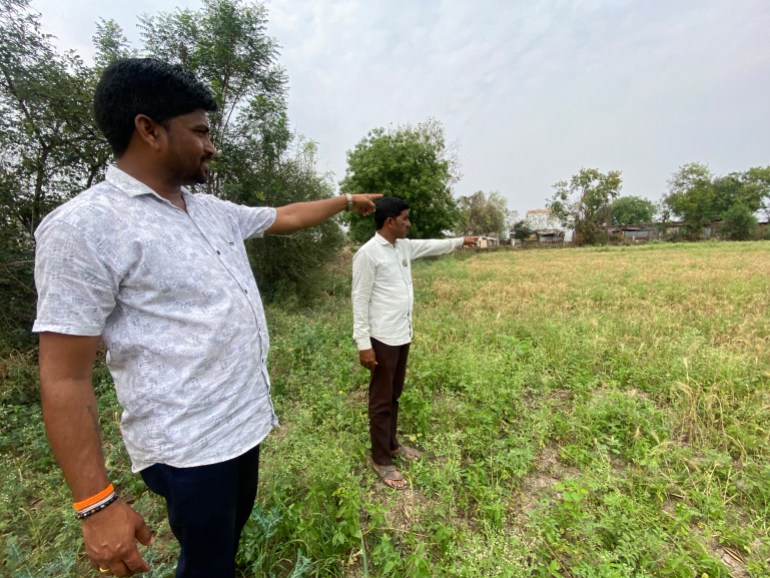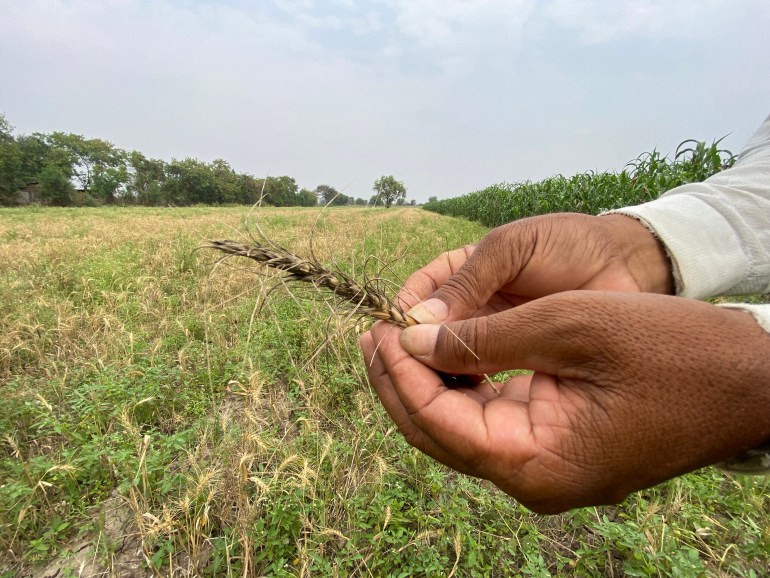Yavatmal, India – Like everyone else around him, Vithal Rathod was excited for what the future held for him and their village when Narendra Modi became India’s prime minister on May 26, 2014.
Just two months earlier, on March 20 that year, Modi had picked the 45-year-old farmer’s village of Dabhadi from the more than 15,500 villages in the Vidarbha region of the western Indian state of Maharashtra to launch his outreach to the country’s farmers. The visit was important for Modi, eyeing the PM’s chair at the time, to be able to reach out to the 65 percent of India’s population that is engaged in agriculture.
During his visit to Dabhadi, Modi had sipped tea with farmers like Rathod, visited farms in the village and promised an end to the death and despair that had long haunted the predominantly rural, impoverished part of Maharashtra state. A lack of adequate irrigation, erratic weather patterns and fluctuating global prices for cotton – the principal crop grown there – meant that farmers suffered repeated losses and found themselves in debt. The resulting frustration drove more than 9,000 farmers to take their own lives between 2001 and 2014.
Modi came and said what the farmers wanted to hear. “Your pain, your struggle and your troubles will force me to do something good,” he told Rathod and the thousands who had gathered to hear him. “I want to tie myself to this promise, I want to talk to experts and find such solutions that no poor farmer has to kill himself,” he said.
Rathod went back home, reassured, to his family of five and tried to put his recurring farm losses behind him. He had a one-hectare (2.5-acre) farm, not far from where Modi spoke.
But by the following year, Rathod’s losses grew and his optimism shrank. In 2015, Rathod became a statistic: he hanged himself to death from the ceiling of his home, just off the main road that leads to Dabhadi village, following another year of crop losses, making his 120,000 rupee debt ($1,440) insurmountable.
Rathod was not alone in feeling let down. Ten years after Modi’s visit, his promise seems to have crumbled – even as India’s prime minister once again campaigns for reelection, this time for a third stint in office.
Data obtained by this correspondent shows the number of farmer suicides in the region has grown in the decade that Modi has been in power, compared with the preceding 10 years when the now-in-opposition Congress party ruled the country.
Between January 2004 and December 2014, 9,671 farmers died by suicide. That number rose to 10,122 for the period from January 2015 to December 2023, according to information collected from the Amravati Divisional Commissionerate in Vidarbha, which oversees the administration of five of the country’s districts worst affected by suicides: Amravati, Yavatmal, Buldhana, Akola and Washim. The actual number of farm suicides in the region under Modi is even higher – since the PM came to power in May 2014.
On average, between 2004 and 2014, each year would see this region record an average of 879 suicide deaths by farmers. Since 2015, that number has risen to 1,125 suicides each year, on average – or three farmers taking their lives every day.
The paradox of Maharashtra, the country’s richest state where Modi’s Bharatiya Janata Party (BJP) has been in power locally for most of the past decade, also serving as the nerve centre of the country’s agrarian crisis, has only deepened over the past decade.
Now, as India’s national election rolls on, the anger over failed promises is visible in farm pockets across the region – parts of which vote on Friday, April 26.
Nowhere more than in Dabhadi itself.

Schemes that go nowhere
In the Rathod household, nine years after their principal breadwinner’s suicide, the family’s struggles have remained static – despite Modi government schemes that are meant to benefit farmer families like theirs.
Rameshwar, 25, Rathod’s son, had to quit his studies after his father’s death. Rameshwar has instead been doing what his father did – making the most of their one-hectare farm while falling deeper into debt.
Last year, he sowed cotton on his farm, but unexpectedly heavy rainfall washed his crops away. “I expected 40 quintals [4 tonnes] of cotton produce, but ended up getting only 5 quintals [500kg or 1,100 pounds],” Rameshwar says, standing outside the room where his father hung himself.
He turned to the Modi government’s flagship scheme, the Pradhan Mantri Fasal Bima Yojana (PMFBY), a crop insurance scheme meant to compensate farmers for such losses. The scheme is meant to “provide a comprehensive insurance cover against failure of the crop thus helping in stabilising the income of the farmers”, according to the initiative’s website.
A back-of-the-envelope showed him his losses were close to 235,000 rupees ($2,815). He applied for the insurance money but got only 10,000 rupees ($120), an amount determined based on local officials’ estimate of the damage his farm suffered.
Putting on a brave face, he hoped the next crop he sowed, wheat, could help him recoup his losses. But in March this year, a hailstorm in the region destroyed nearly half his standing crop. He has, yet again, applied for compensation under the PMFBY. A month later, Rameshwar is still waiting.
Like his father, Rameshwar is now running high debts. His father was impressed by Modi, but he is not. Rameshwar is going to back the opposition parties in these polls.
Many others in his village have had a similar reversal of feelings.

A change of heart
Narendra Dabhane, the former village chief of Dabhadi, used to be “so spellbound by Modi that I would scold those who would criticise him”, he says, sitting in the courtyard of his home in the village.
“I used to tell people, he is a man sent by God to help us,” Dabhane says, with an embarrassed smile. “I kept thinking that our village was going to become a paradise, now that the PM had made such emphatic promises.”
Within months of Modi coming to power, though, Dabhane started feeling betrayed.
Modi, in his speech, had proposed what seemed to be a revolutionary idea, what he called the “5F formula from farm to fibre to fabric to fashion to foreign” – the idea that their cotton produce could be converted to readymade garments right here, in Vidarbha. The result would be that factories would be set up, so the children of farmers could be employed. The garments would then be exported around the world. That was the dream that Dabhadi was sold.
None of that happened. Dabhane does not know of any such supply chains being developed – both of his sons had to migrate to neighbouring districts to get jobs.
Last year, Dabhane sowed cotton on his 1.2-hectare (three-acre) farm just outside the village. Much of his crop was damaged in the rains, and the remaining fetched a price of 6,800 rupees per quintal ($81 per 100 kilos) of cotton. His earnings are “less than what I used to get for my cotton 10 years ago”, he said.
Government data shows that there had been a 74 percent increase in state-mandated support price for medium-staple cotton, from 3,800 rupees ($46) in 2015-16 to 6,620 rupees ($79) in 2024-25.
But many farmers insist that traders seldom heed these prices. And Dabhane points to what this data does not reveal.
“All the inputs that go into the farm have become exorbitantly expensive,” he said. “A bag of fertiliser that cost us 500 rupees [$6] 10 years ago, is now nearly 1,700 rupees [$20],” he said. “We are also paying the [Modi government-introduced] Goods and Services Tax on everything from pesticides to tractors,” he said.
Like Rathod, Dabhane, too, suffered heavy losses twice in the last few months with his cotton and wheat crops failing due to poor weather. But unlike Rathod, who at least got a measly 10,000 rupees, Dabhane got nothing, he said.
All this has meant that while Modi, in February 2016, had said he “dreamed” that farmers’ incomes would “double” by 2022, farmers like Dabhane have seen their real incomes shrinking.
From a Modi supporter, Dabhane has now turned into a fierce critic. In February this year, when Modi visited Yavatmal district, under which Dabhadi falls, Dabhane and a few others put up banners listing out 16 promises they said Modi made to them in his 2014 speech in the village.
“We even made black chai on that day,” he says, laughing, as a riposte to Modi’s famed Chai Pe Charcha (Chats over Chai) campaign. During his 2014 election outreach, Modi – who says he used to sell tea or chai at a railway station as a young man – helped campaign events over cups of tea to underscore those humble beginnings. The local police, he said, arrested him for the protest and released him after Modi left.
The crisis has affected not just smaller farmers like Dabhane, but also many others who are ambitious and are trying to make farming a more sustainable source of livelihood.
Prithviraj Pawar, 43, owns two hectares (five acres) and has leased another six hectares (15 acres), to be able to cultivate crops like soybean and wheat. Last year, Pawar’s two-hectare cultivate of soybeans suffered severe losses, his yield falling from the expected 25 quintals to merely 12 quintals, his losses over 60,000 rupees ($720). “The insurance scheme only gave me 11,000 rupees [$132], which did not even remotely cover my expenses, leave alone my losses.”
Pawar has a unique connection to Modi – he is now cultivating, on a lease, the farm on which Modi held his 2014 event. This year, though, the farm is mostly dry and the wheat crop stunted due to the hailstorm in March that also destroyed Rameshwar’s crop.
Such lived experiences, along with the Modi government’s chequered record in dealing with farmers – from bringing in three controversial new laws to regulate Indian agriculture in 2020, to repeated instances of police violence against protesting farmers – have made many in Vidarbha wary of the government’s intent.
On his part, Modi has repeatedly tried to reach out to the farming community in the region. He has already held three public meetings in the region, including one in the neighbouring Wardha district on April 19 where he reportedly blamed the opposition Congress responsible for the “longstanding challenges farmers faced in the country”.
But many like Dabhane and Rathod, and others across the region, remain unconvinced and bitter. To them, new speeches are not going to wash away old betrayals.

